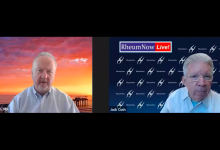New Treatments in Axial SpA from #ACR2019 Save

There were new developments in the treatment of axial Spondyloarthritis (AS) at ACR 2019. The first area is on the use of anti-IL17A drugs, secukinumab and ixekizumab in non-radiographic AS. The second area is the use of JAK-1 inhibitor Upadacitinib in radiographic AS. The third area is the use of dual anti-IL17A and 17F drug bimekizumab in radiographic. Finally, there were reports of the benefit of using anti-TNF (certolizumab) earlier in diagnosis to prevent radiographic progression. I will cover these topics here.
Up to now, the anti-IL17A agent secukinumab has been approved for use in radiographic AS. With earlier diagnosis, increasingly more patients that we see in clinic are in the non-radiographic (nr) AS phase. Anti-TNF drugs (eg. adalimumab, etanercept, certolizumab, golimumab) have been shown to be effective in nr-AS. Having anti-IL17A will be useful in cases where anti-TNF has failed in nr-AS. In the PREVENT study (late breaking abstract L21), 555 nr-AS patients were recruited into this Phase 3 study. Patients received 150mg of Secukinumab loading or without loading dose against placebo in a 1:1:1 randomisation, followed by monthly injections. At 16 weeks, the primary endpoint of ASAS40 was met in 42% of Secukinumab treated patients against 29% in the placebo group. The high placebo response may have been due to the fact that about 90% of patients were anti-TNF naïve and had back pain for greater than 8 years. This could have possibly led to the higher expectation of a response from treatment in the placebo group. In the second study on another anti-IL17A, Ixekizumab, IXE (abstract 2729), the COAST-X study looked nr-AS patients with greater than 10 years of back pain. Patients were randomised 1:1:1 to Ixekizumab 80mg every 2 weeks, 4 weeks or to placebo. The primary endpoint was ASAS40 at weeks 16 and 52. At week 16, the response of placebo, IXE 2 weekly and IXE 4 weekly was 19%, 40%, 35% respectively. At week 52, ASAS 40 was 13%, 31%, 30% in the 3 respective groups. In both studies there were no new safety signals beyond what is already known from other studies. Both these studies add to the treatment options for nr-AS and anti-IL-17A are effective in this condition.
Janus kinase (JAK) inhibitors have now been used and studied in AS. In abstract #2728, updacitinib (UPA) 15mg was compared to placebo (PBO). 187 patients were assigned 1:1 to UPA or PBO. At Week 14, more patients achieved ASAS40 in the UPA group (51.6%) versus placebo (25.5%). There were no new safety signals in the UPA group compared to previous studies of this drug.
Dual inhibition of IL-17 A and F with bimekizumab in AS was studied up to week 48 in abstract #0937. 303 patients were randomized 1:1:1:1:1 to subcutaneous (sc) bimekizumab 16 mg, 64 mg, 160 mg, 320 mg, or placebo every 4 weeks. At Week 12, significantly more bimekizumab-treated pts vs placebo achieved ASAS40 (16 mg 29.5%; 64 mg 42.6%; 160 mg 46.7%; 320 mg 45.9%; placebo 13.3%; p 0.05, all doses). ASAS40 response rates increased to Week 24 and were maintained to Week 48 (35.5–64.0%). Bimekizumab was generally well tolerated and no new or unexpected safety findings were identified.
The earlier use of anti-TNF in AS is supported by abstract #0936. Certolizumab (CZP) was used in patients with nr-AS in a phase 3 study, C-axSpAnd. 317 patients were randomised 1:1 to CZP versus PBO. Using a cut-off of 3 years symptom duration, responder rates for ASDAS-MI and ASAS40 were greater in CZP-treated pts with shorter symptom duration: at Wk 52, 56.4% (31/55) and 42.3% (44/104) of pts with 3 and ≥ 3 years symptom duration achieved ASDAS-MI, respectively, while 65.5% (36/55) and 51.9% (54/104) achieved ASAS40. CZP-treated nr-axSpA pts with shorter symptom duration showed greater improvements across signs and symptoms of disease and in quality of life.
These abstracts from #ACR19 highlight three important take home messages for me, and these are
There are new therapeutic modes of action beyond anti-TNF in AS. In nr-AS, IL-17A inhibitors and in r-AS, JAK inhibitors and IL-17A and F inhibitors provide new modes of action in AS.
The primary outcome measure has been raised in studies from ASAS20 to ASAS40.
Earlier treatment with Anti-TNF improves outcome measures.
I hope you will find this article helpful as you navigate the newer therapies in your clinics.










If you are a health practitioner, you may Login/Register to comment.
Due to the nature of these comment forums, only health practitioners are allowed to comment at this time.